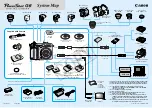
134 / Detailed guide /
Record mode
Setting the exposure
The LEICA DIGILUX 2 offers you a choice of four
exposure modes, with which you can adjust the
camera perfectly to your preferred working method or
the relevant subject.
All modes are chosen and manual settings of the rele-
vant values are made with the lens aperture setting
ring (1.9) and the shutter speed dial (1.16). Both of
these operating elements have manual setting ranges
with click-stop positions – for the aperture setting ring
in
1
/
3
-steps, and the speed dial in whole steps, and
they each also have an automatic position marked
with
A
(1.9 a/1.16 a).
Both automatic positions are protected against acci-
dental adjustments: on the aperture setting ring, the
release button (1.9 b) must be kept depressed when
changing from the manual range to the automatic
position and back again. In the less ‘vulnerable’
shutter speed dial, the much more noticeable click-
stops serve this purpose.
Shutter speeds of
1
/
2
2
s and slower – on the shutter
speed dial this corresponds to position
2+
– are set
with the central setting dial (1.29): towards the left
(anticlockwise) for faster, towards the right (clock-
wise) for slower speeds.
• As an indication of this,
a
(2.1.19) appears in the
viewfinder/monitor when the shutter speed dial is
set to
2+
.
Notes:
• Depending on the prevailing light conditions, the
brightness of the monitor screen can differ from
that of the actual pictures taken. Particularly for
long exposures on dark subjects, the monitor
screen appears considerably darker than the –
correctly exposed – picture.
• If your main subject is to be off-center, and cannot
be detected by the autofocus metering area, you
should use the exposure/focus metering memory-
lock function (see p. 132).
• In the case of slow shutter speeds where there is a
risk of blurring, the warning
v
(2.1.13) also
appears.
• To prevent blurred pictures with dark subjects
where a flash is not used
O
, or with the flash
modes
J
/
P
(2.1.2 g/e/f, see p. 140) and the
generally slower shutter speeds, you should hold
the camera steady, i. e. support it or use a tripod.
• If the automatic review function is set
B
AUTO
REVIEW
, (3.15, see p. 146) the picture will appear
in the viewfinder/monitor for around 2 s after it has
been taken.
• If you have set an automatic switch off time
(see p. 125), the camera automatically switches to
an energy-saving stand-by mode after the selected
time. You can activate it again either by pressing
the shutter release button or by turning if off and
back on again.
• The significantly smaller sensor size – compared to
the 24 x 36 mm format – and the considerably shor-
ter focal lengths that result influence the composi-
tion: due to the considerable depth of field at full
stop and also the minimal differences between
adjacent apertures, you need to open up much
more than in 35 mm cameras to reduce the depth
of field and even the smallest possible depth of
field still has a significantly bigger expansion.
Taking photographs with programmed automatic
exposure mode - P
For fast, fully automatic photography. In this mode,
the exposure is controlled by the automatic setting of
shutter speeds and apertures.
Here, the LEICA DIGILUX 2 uses shutter speeds in the
range of 8 s to
1
/
4000
s and apertures from 2–11.
To set this mode, turn
1. the lens aperture setting ring (1.9) to its
A
position
(1.9 a), and
Содержание Digilux 2
Страница 1: ...LEICA DIGILUX 2 Anleitung Instructions ...
Страница 3: ...1 39 1 40 1 44 1 41 1 38 1 37 1 37 1 52 1 53 1 52 1 50 1 51 1 48 1 49 1 45 1 46 1 45 1 47 ...
Страница 4: ...LEICA DIGILUX 2 Anleitung English instructions pages 97 189 ...
Страница 6: ...3 ...
Страница 97: ......
Страница 98: ......
Страница 99: ...LEICA DIGILUX 2 Instructions Illustrations inside front and rear covers ...














































